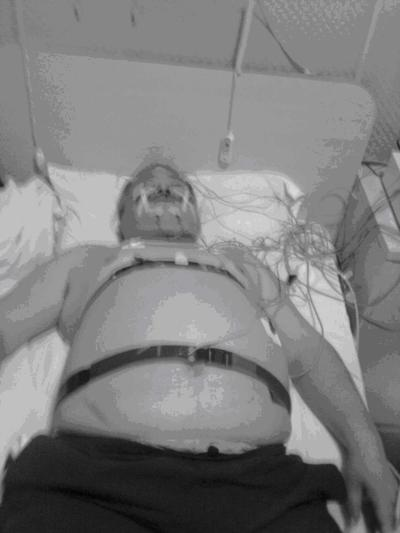Method for determining severity of obstructive sleep apnea hypopnea syndrome (OSAHS) according to snore acoustic characteristics
A sleep apnea and severity technology, applied in the evaluation of respiratory organs, etc., can solve the problems of reducing patient comfort, discounting the practicality and universality of PSG equipment, and not correctly reflecting the patient's state, achieving low requirements and low cost. Inexpensive and easy to detect
- Summary
- Abstract
- Description
- Claims
- Application Information
AI Technical Summary
Problems solved by technology
Method used
Image
Examples
Embodiment 1
[0021] Embodiment one: see Figure 4 , Figure 5 and Figure 6 , determine the severity of obstructive sleep apnea and hypopnea syndrome (OSAHS) according to the acoustic characteristics of snoring, characterized in that:
[0022] (1) Establish four reference models with different OSAHS severities: count the formant distribution of different OSAHS severities, and establish four reference models with different OSAHS severities according to the SBFP characteristic parameters, namely: simple snoring model, mild Moderate OSAHS model, moderate OSAHS model and severe OSAHS model;
[0023] (2) Detect snoring and calculate its SBFP characteristic parameters: record the subject's snoring, and calculate the SBFP characteristic parameters of its snoring;
[0024] (3) Match the SBFP characteristic parameters with four reference models: match the four reference models in step (1) according to the SBFP acoustic characteristic parameters of the subject, and the model with the largest matc...
Embodiment 2
[0026] Embodiment Two: This embodiment is basically the same as Embodiment Two, and the special features are as follows:
[0027] The step (1) needs to establish four reference models with different OSAHS severities:
[0028] 1) Obtain a large number of snoring sounds with different OSAHS severities, among which different OSAHS severities are obtained from the PSG monitoring results of the hospital, and the PSG monitoring results must be correct; each type of OSAHS experiment needs more than 500, that is, patients with four OSAHS levels at least 500 people each; for OSAHS patients, it is necessary to combine the MicL signal in Alice to synchronize the Alice signal with the snoring sound, and intercept the corresponding snoring sound inspiratory segment according to the apnea hypopnea position calibrated by medical diagnosis, as the experimental data of statistical acoustic laws; For patients with simple snoring, the inspiratory segments of all snoring sounds can be us...
Embodiment 3
[0036] Such as Figure 4 As shown, there are four steps to determine the severity of OSAHS according to the SBFP acoustic characteristics of snoring:
[0037] (1) "Off-line analysis" of the acoustic laws of different OSAHS severity levels, and four models of different OSAHS severity levels are established; (here based on the existing data analysis rules, rather than real-time recording data analysis, so it is called offline analysis)
[0038] (2) "Online analysis" calculates the SBFP characteristic parameters of the subjects; (online analysis refers to the processing of real-time recording data)
[0039] (3) four models of the off-line analysis in the SBFP matching (1) that are calculated in the step (2), determine the model that the subject matches according to the maximum probability;
[0040] (4) Results display: Determine the severity of OSAHS according to the matching model, and display the severity of OSAHS, the number of snoring sounds and the corresponding time.
[0...
PUM
 Login to View More
Login to View More Abstract
Description
Claims
Application Information
 Login to View More
Login to View More - R&D
- Intellectual Property
- Life Sciences
- Materials
- Tech Scout
- Unparalleled Data Quality
- Higher Quality Content
- 60% Fewer Hallucinations
Browse by: Latest US Patents, China's latest patents, Technical Efficacy Thesaurus, Application Domain, Technology Topic, Popular Technical Reports.
© 2025 PatSnap. All rights reserved.Legal|Privacy policy|Modern Slavery Act Transparency Statement|Sitemap|About US| Contact US: help@patsnap.com



